中西方教育差异(英文)
- 格式:ppt
- 大小:2.24 MB
- 文档页数:12
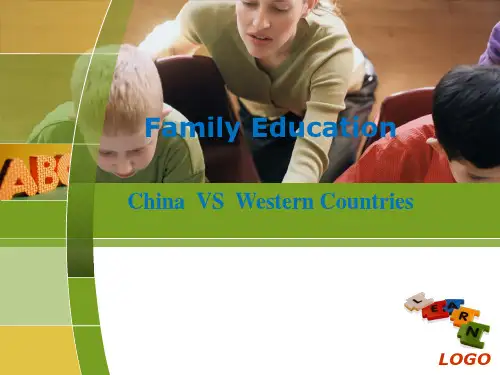
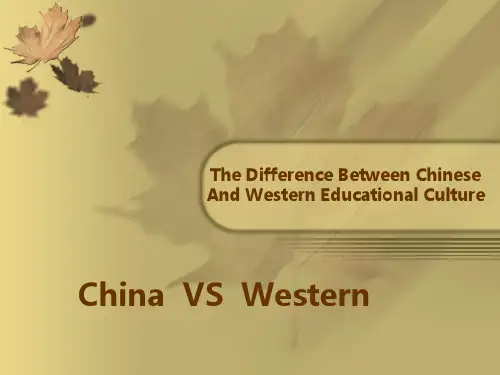
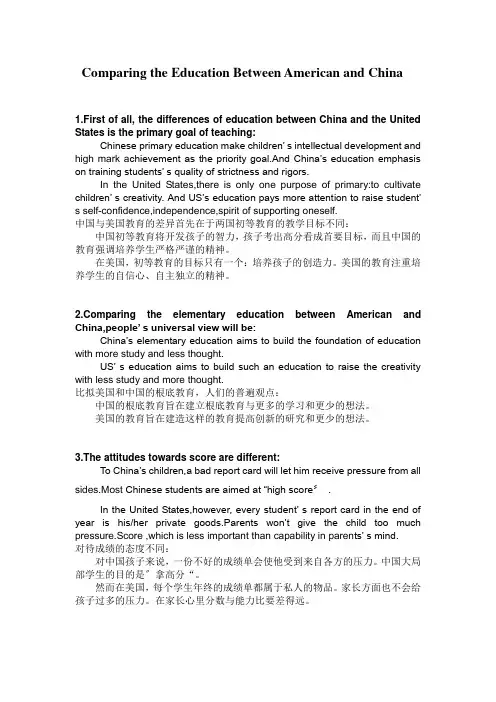
Comparing the Education Between American and China1.First of all, the differences of education between China and the United States is the primary goal of teaching:Chinese primary education make children’ s intellectual development and high mark a chievement as the priority goal.And China’s education emphasis on training students’ s quality of strictness and rigors.In the United States,there is only one purpose of primary:to cultivate children’ s creativity. And US’s education pays more attention to raise student’ s self-confidence,independence,spirit of supporting oneself.中国与美国教育的差异首先在于两国初等教育的教学目标不同:中国初等教育将开发孩子的智力,孩子考出高分看成首要目标,而且中国的教育强调培养学生严格严谨的精神。
在美国,初等教育的目标只有一个:培养孩子的创造力。
美国的教育注重培养学生的自信心、自主独立的精神。
paring the elementary education between American and China,people’ s universal view will be:China’s elementary education aims to build the foundation of education with more study and less thought.US’ s education aims to build such an education to raise the creativity with less study and more thought.比拟美国和中国的根底教育,人们的普遍观点:中国的根底教育旨在建立根底教育与更多的学习和更少的想法。

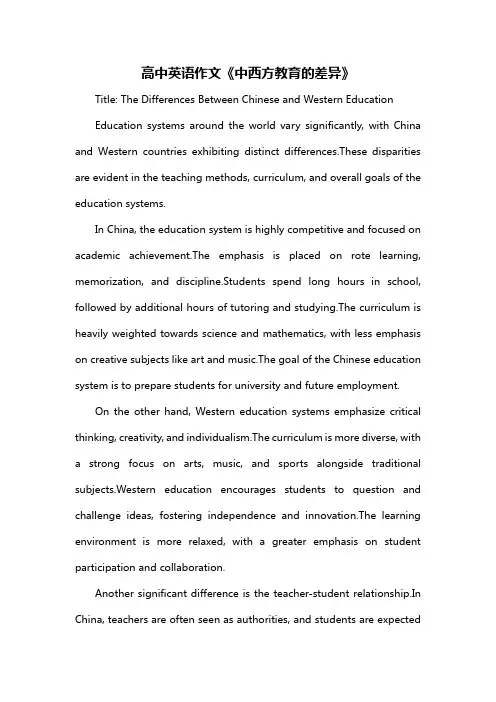
高中英语作文《中西方教育的差异》Title: The Differences Between Chinese and Western EducationEducation systems around the world vary significantly, with China and Western countries exhibiting distinct differences.These disparities are evident in the teaching methods, curriculum, and overall goals of the education systems.In China, the education system is highly competitive and focused on academic achievement.The emphasis is placed on rote learning, memorization, and discipline.Students spend long hours in school, followed by additional hours of tutoring and studying.The curriculum is heavily weighted towards science and mathematics, with less emphasis on creative subjects like art and music.The goal of the Chinese education system is to prepare students for university and future employment.On the other hand, Western education systems emphasize critical thinking, creativity, and individualism.The curriculum is more diverse, with a strong focus on arts, music, and sports alongside traditional subjects.Western education encourages students to question and challenge ideas, fostering independence and innovation.The learning environment is more relaxed, with a greater emphasis on student participation and collaboration.Another significant difference is the teacher-student relationship.In China, teachers are often seen as authorities, and students are expectedto respect and obey them.The teacher-student relationship is more formal, and there is less interaction outside the classroom.In contrast, Western education promotes a more equal and informal relationship between teachers and students.Teachers encourage student input and create a supportive environment for students to express their opinions.Moreover, assessment methods differ between Chinese and Western education systems.In China, exams and assessments are crucial, with a strong emphasis on test scores.The education system is highly competitive, and students' future opportunities are often determined by their performance in exams.In contrast, Western education places less emphasis on exams and more on coursework, projects, and presentations.Assessment is more comprehensive, taking into account students' overall performance and participation.In conclusion, the differences between Chinese and Western education systems are evident in teaching methods, curriculum, and assessment.While Chinese education emphasizes academic achievement and discipline, Western education focuses on critical thinking, creativity, and individualism.Understanding these differences can help us appreciate the unique strengths of each education system and potentially inform improvements in our own systems.。
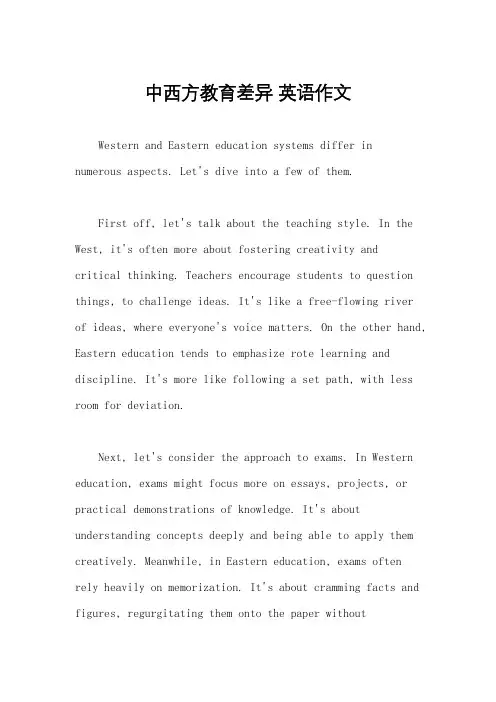
中西方教育差异英语作文Western and Eastern education systems differ in numerous aspects. Let's dive into a few of them.First off, let's talk about the teaching style. In the West, it's often more about fostering creativity andcritical thinking. Teachers encourage students to question things, to challenge ideas. It's like a free-flowing riverof ideas, where everyone's voice matters. On the other hand, Eastern education tends to emphasize rote learning and discipline. It's more like following a set path, with less room for deviation.Next, let's consider the approach to exams. In Western education, exams might focus more on essays, projects, or practical demonstrations of knowledge. It's about understanding concepts deeply and being able to apply them creatively. Meanwhile, in Eastern education, exams oftenrely heavily on memorization. It's about cramming facts and figures, regurgitating them onto the paper withoutnecessarily understanding the underlying principles.Now, let's touch on the role of extracurricular activities. In the West, there's a strong emphasis on extracurriculars. Schools encourage students to exploretheir interests outside of the classroom, whether it's sports, arts, or community service. It's seen as essential for personal development and well-roundedness. In contrast, Eastern education tends to prioritize academic achievement above all else. There's less emphasis on extracurriculars, and more pressure to excel academically.Moving on, let's talk about the teacher-student relationship. In Western education, there's often a more informal and friendly dynamic between teachers and students. Students are encouraged to approach teachers as mentors and guides, to seek help when needed. It's all about fosteringa supportive learning environment. In Eastern education,the relationship is often more formal and hierarchical. There's a greater emphasis on respecting authority and following instructions without question.Lastly, let's touch on the overall goal of education.In the West, education is often seen as a means to personal growth and fulfillment. It's about discovering one's passions, honing one's skills, and becoming a well-rounded individual. In contrast, in many Eastern societies, education is viewed more instrumentally, as a means to career success and societal advancement. There's often immense pressure to excel academically and secure a prestigious job.These are just a few examples of how Western andEastern education systems differ. Despite their differences, both systems have their strengths and weaknesses, andthere's much that each can learn from the other.。
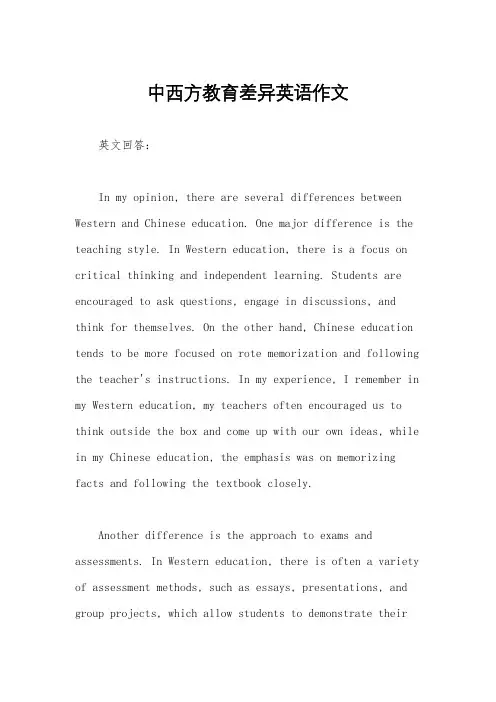
中西方教育差异英语作文英文回答:In my opinion, there are several differences between Western and Chinese education. One major difference is the teaching style. In Western education, there is a focus on critical thinking and independent learning. Students are encouraged to ask questions, engage in discussions, and think for themselves. On the other hand, Chinese education tends to be more focused on rote memorization and following the teacher's instructions. In my experience, I remember in my Western education, my teachers often encouraged us to think outside the box and come up with our own ideas, while in my Chinese education, the emphasis was on memorizing facts and following the textbook closely.Another difference is the approach to exams and assessments. In Western education, there is often a variety of assessment methods, such as essays, presentations, and group projects, which allow students to demonstrate theirunderstanding in different ways. In Chinese education, exams are the primary form of assessment, and there is a heavy emphasis on scoring well on standardized tests. For example, when I was studying in the West, I had the opportunity to do a group project where we had to research and present our findings, which was a great opportunity to work with my peers and develop my communication skills. On the other hand, in my Chinese education, I had to take multiple choice exams that tested my ability to recall information.中文回答:在我看来,中西方教育有几个不同之处。
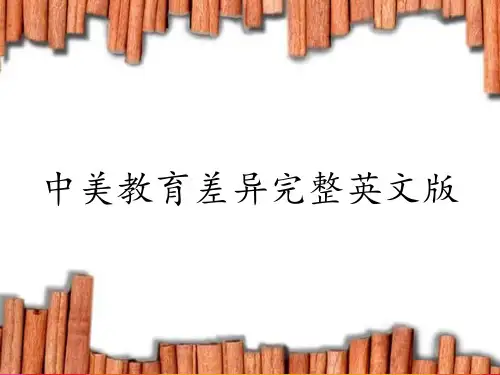
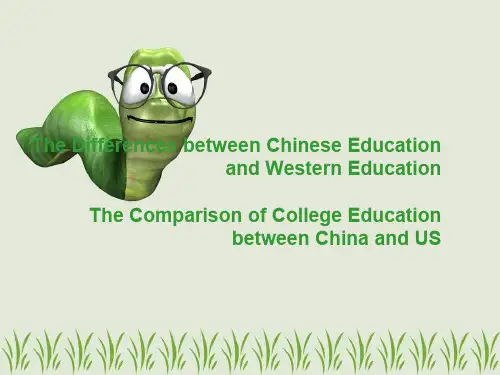
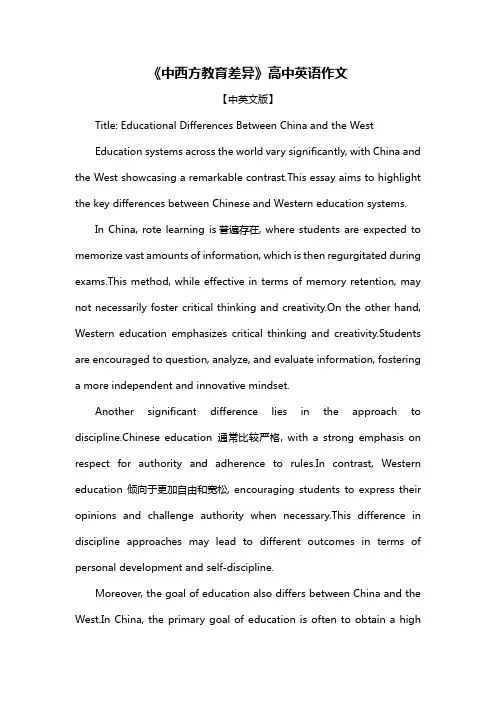
《中西方教育差异》高中英语作文【中英文版】Title: Educational Differences Between China and the WestEducation systems across the world vary significantly, with China and the West showcasing a remarkable contrast.This essay aims to highlight the key differences between Chinese and Western education systems.In China, rote learning is普遍存在, where students are expected to memorize vast amounts of information, which is then regurgitated during exams.This method, while effective in terms of memory retention, may not necessarily foster critical thinking and creativity.On the other hand, Western education emphasizes critical thinking and creativity.Students are encouraged to question, analyze, and evaluate information, fostering a more independent and innovative mindset.Another significant difference lies in the approach to discipline.Chinese education通常比较严格, with a strong emphasis on respect for authority and adherence to rules.In contrast, Western education倾向于更加自由和宽松, encouraging students to express their opinions and challenge authority when necessary.This difference in discipline approaches may lead to different outcomes in terms of personal development and self-discipline.Moreover, the goal of education also differs between China and the West.In China, the primary goal of education is often to obtain a highscore on the college entrance examination, which is seen as the gateway to a successful future.As a result, students often face immense pressure to excel academically.In contrast, Western education places more emphasis on overall development,包括社交技能、情感发展和创造力。
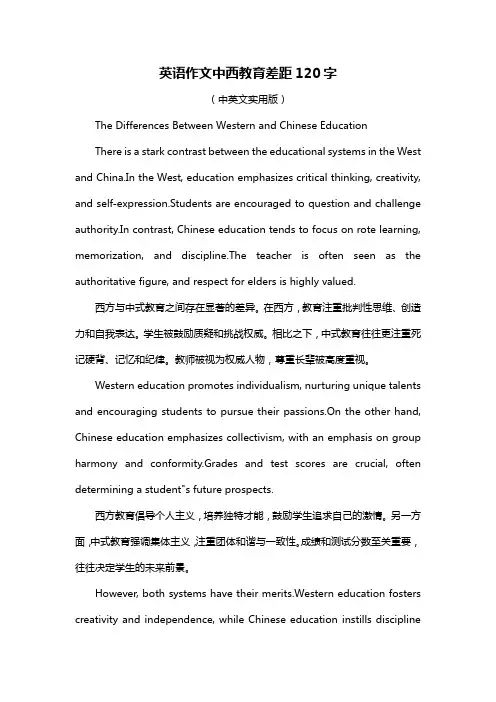
英语作文中西教育差距120字(中英文实用版)The Differences Between Western and Chinese EducationThere is a stark contrast between the educational systems in the West and China.In the West, education emphasizes critical thinking, creativity, and self-expression.Students are encouraged to question and challenge authority.In contrast, Chinese education tends to focus on rote learning, memorization, and discipline.The teacher is often seen as the authoritative figure, and respect for elders is highly valued.西方与中式教育之间存在显著的差异。
在西方,教育注重批判性思维、创造力和自我表达。
学生被鼓励质疑和挑战权威。
相比之下,中式教育往往更注重死记硬背、记忆和纪律。
教师被视为权威人物,尊重长辈被高度重视。
Western education promotes individualism, nurturing unique talents and encouraging students to pursue their passions.On the other hand, Chinese education emphasizes collectivism, with an emphasis on group harmony and conformity.Grades and test scores are crucial, often determining a student"s future prospects.西方教育倡导个人主义,培养独特才能,鼓励学生追求自己的激情。
中西教育差异英语作文英文回答:In the realm of education, substantial disparities exist between the educational systems of the East and the West. These differences manifest in various aspects, including pedagogical approaches, cultural norms, and societal expectations.One of the most striking contrasts lies in the pedagogical approach. Western educational institutions emphasize critical thinking, analytical reasoning, and independent learning. Students are encouraged to question, challenge, and form their own opinions. This approach fosters intellectual curiosity and prepares students to navigate the complexities of the modern world.In contrast, Eastern educational systems often prioritize rote memorization and conformity. Students are expected to absorb vast amounts of knowledge withoutquestioning its veracity. This approach values obedienceand respect for authority, aiming to develop a stable and harmonious society.Cultural norms also play a significant role in shaping educational practices. In Western societies, individualismis highly valued. Students are encouraged to express their unique perspectives and pursue their passions. This fosters creativity, innovation, and a sense of personal accomplishment.In Eastern cultures, collectivism takes precedence. Students are taught to prioritize the interests of thegroup over their own. This emphasis on social harmony and cooperation promotes a sense of belonging and mutual support.Societal expectations also differ between the East and the West. In Western societies, education is seen as a means to achieve individual success and economic prosperity. Students are expected to excel academically and secure prestigious degrees. This pressure can lead to acompetitive and stressful learning environment.In Eastern societies, education is viewed as a lifelong journey of personal growth and self-improvement. Students are encouraged to cultivate virtues such as diligence, humility, and perseverance. This holistic approach emphasizes the development of a well-rounded individual who contributes to the well-being of society.To illustrate these differences, consider the teaching styles in math classrooms. In Western classrooms, teachers often employ interactive methods that encourage student participation and critical thinking. They pose open-ended questions, facilitate group discussions, and provide personalized feedback.In Eastern classrooms, teachers typically focus on delivering content through lectures and note-taking. Students are expected to memorize formulas and algorithms without much room for questioning or exploration. This approach emphasizes efficiency and standardization.Another key difference lies in the assessment methods. Western educational systems rely heavily on standardized testing to evaluate student performance. These tests measure cognitive abilities and academic knowledge. This approach emphasizes objective measurement and accountability.Eastern educational systems, on the other hand, often utilize a more holistic approach to assessment. Students are evaluated not only on their academic performance but also on their character, effort, and contributions to the class. This approach fosters a sense of community and encourages all students to participate.In conclusion, the educational systems of the East and the West exhibit fundamental differences in their pedagogical approaches, cultural norms, and societal expectations. These disparities reflect the unique values and priorities of each society and influence the way students learn, think, and develop.中文回答:中西方教育差异显而易见,体现在教学方法、文化理念和社会期待等多个方面。
中西方教育差异英语作文英文回答:In terms of education, there are definitely some differences between the East and the West. One of the main differences is the teaching style. In the West, the teaching style is often more interactive and student-centered. Teachers encourage students to ask questions and engage in discussions, and there is a focus on critical thinking and problem-solving skills. On the other hand, in the East, the teaching style is often more traditional and teacher-centered. Students are expected to listen to the teacher and memorize information, and there is less emphasis on critical thinking and more emphasis on rote learning.Another difference is the attitude towards failure. In the West, failure is often seen as a natural part of the learning process and is not stigmatized. Students are encouraged to take risks and learn from their mistakes. Inthe East, however, there is often a strong aversion to failure, and students may feel a lot of pressure to succeed. This can lead to a fear of taking risks and a reluctance to try new things.Furthermore, the subjects taught in schools can also differ between the East and the West. In the West, there is often a greater emphasis on the arts and humanities, and students are encouraged to explore their creativity. In the East, there is often a greater emphasis on subjects like math and science, and there is a focus on academic achievement.中文回答:在教育方面,东西方之间确实存在一些差异。
中西方教育差异英语作文In the realm of education, the differences between Eastern and Western educational systems are quite pronounced, reflecting the cultural, historical, and philosophical underpinnings of each region. Here is a composition that delves into these differences:The Diverse Landscape of Education: A Comparative Look at Eastern and Western SystemsEducation is a cornerstone of societal development, and the way it is administered varies greatly across the globe. The Eastern and Western educational systems, in particular, exhibit distinct characteristics that shape the learning experiences of students.Eastern Education: Tradition and DisciplineIn Eastern countries, particularly in regions like China, Japan, and South Korea, education is often rooted in a deep respect for tradition and authority. The educational approach is typically more structured and formal. Students are expected to follow a rigid curriculum with a strong emphasis on rote learning and memorization. Teachers are highly respected figures, and their authority is rarely questioned. The focus is on discipline and the mastery of core subjectssuch as mathematics, science, and languages. The goal is to prepare students for rigorous standardized tests that determine their future academic and professional trajectories.Western Education: Creativity and Critical ThinkingConversely, Western education systems, prevalent in countries like the United States, Canada, and much of Europe,prioritize creativity and critical thinking. The classroom environment is more relaxed and encourages open dialogue between students and teachers. The curriculum is designed tobe flexible, allowing for exploration and the pursuit of individual interests. Students are encouraged to question, analyze, and form their own opinions. The emphasis is on developing well-rounded individuals who can think independently and solve problems creatively.Cultural Impact on Teaching MethodsThe cultural values of each region significantly influencethe teaching methods. In Eastern cultures, where collectivism is more prevalent, the focus is on group harmony and the collective good, which translates into a more uniform educational approach. In contrast, Western cultures, whichtend to value individualism, foster an educationalenvironment where individual expression and personal growthare celebrated.Outcomes and ChallengesWhile Eastern students often excel in internationalassessments, particularly in subjects like math and science, there is a growing concern about the potential stifling of creativity and innovation due to the rigid nature of the system. Western education, on the other hand, faceschallenges related to maintaining academic rigor while promoting creativity, as well as addressing disparities in educational outcomes.The Path ForwardThe future of education may lie in finding a balance between the Eastern and Western approaches. Incorporating discipline and a strong foundation in core subjects with the creativity and critical thinking valued in the West could lead to a more holistic educational experience. This synthesis could prepare students to thrive in an increasingly globalized and interconnected world.ConclusionThe differences between Eastern and Western education systems are a testament to the diversity of human thought and culture. As we continue to learn from one another, we can hope tocreate educational environments that are both rigorous and nurturing, fostering a new generation of learners equipped to face the challenges of the 21st century.This composition provides a brief overview of the key differences between Eastern and Western education systems,highlighting the cultural influences on teaching methods and the potential for a balanced approach to learning.。
中式教育和西式教育的区别英语作文There are notable differences between Chinese education and Western education. 中式教育与西式教育之间存在显著的差异。
Chinese education is often perceived as more rigid and focused on rote memorization, while Western education is characterized by a more holistic approach that encourages critical thinking and creativity. 中式教育往往被认为更为刻板,侧重死记硬背,而西式教育则以更全面的方式为特征,鼓励批判性思维和创造力。
In Chinese education, students are typically expected to excel in standardized tests and adhere to strict rules and regulations. 在中国教育中,学生通常被期望在标准化考试中表现出色,并遵守严格的规则和条例。
This can create a high-pressure environment where success is often measured solely by academic achievement. 这可能会创造出一个高压力的环境,成功往往仅通过学业成就来衡量。
On the other hand, Western education places a greater emphasis on individualism and personal development, allowing students more freedom to explore their interests and talents. 另一方面,西式教育更加强调个人主义和个人发展,让学生更多地自由地探索自己的兴趣和才能。